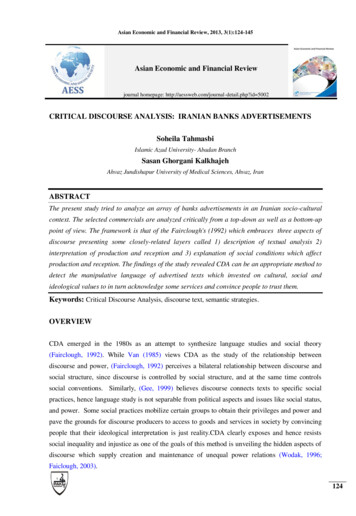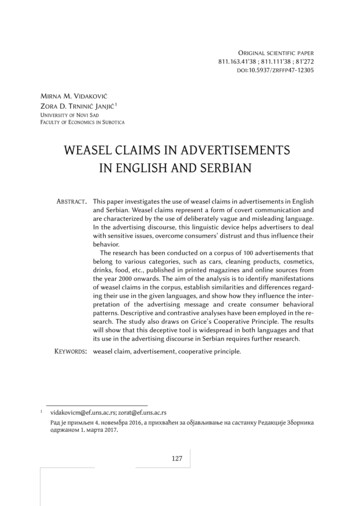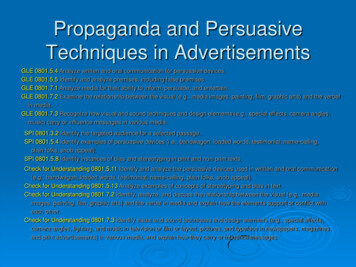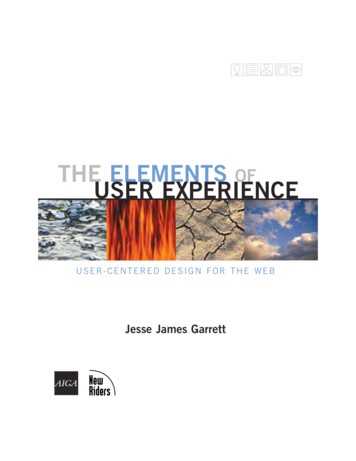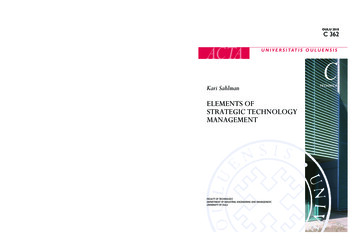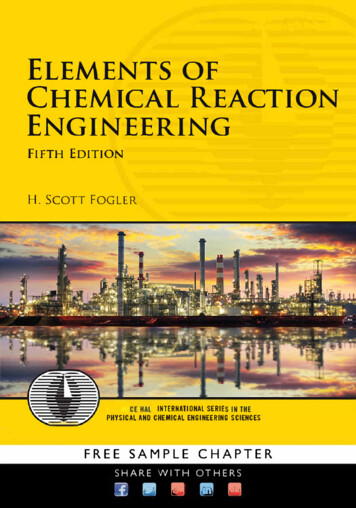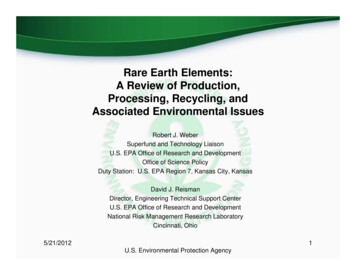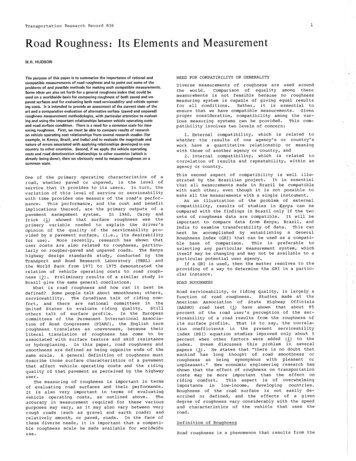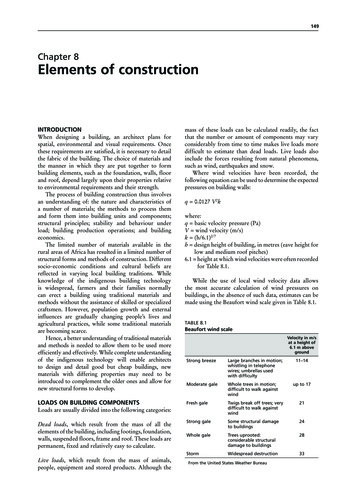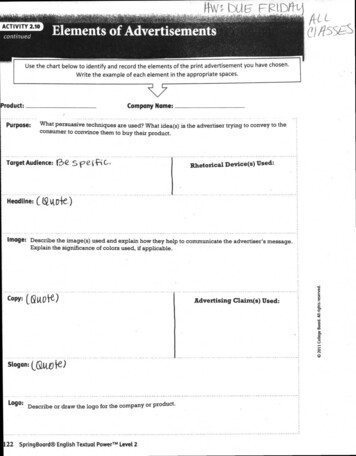
Transcription
Elements of AdvertisementsUse the chart below to identify and record the elements of the print advertisement you have chosen.Write the example of each element in the appropriate spaces.Product:Company Name:. . .Purpose:What persuasive techniques are used? What idea(s) is the advertiser trying to convey to theconsumer to convince them to buy their product.Target Audience: 1 SHeadline: (eeiRhetorical Device(s) Used:9,,,,to e)(Image: Describe the image(s) used and explain how they help to communicate the advertiser's message.Copy: GROi-e)Slogan:a te(JUL)Logo: Describe or draw the logo for the company or product.22 SpringBoard English Textual PowerTM Level 2Advertising Claim(s) Used:C) 2011 Co llege Board. All rights rese rved.Explain the significance of colors used, if applicable.
Elements of AdvertisementsSUGGESTED. LEARNING STRATEGIES: Marking the Text, Skimming/Scanning, Word MapThe following text defines five common elements of printadvertisements. The first three directly relate to ads, while the last twoare associated with the company itself and usually appear in multipleads. As you read through the text below, identify examples of eachelement.Elements of Print AdvertisementsExamplesHeadline: A short piece of text, usually in larger type, designed to bethe first words the audience reads. The headline is usually not theslogan (see below) but is unique to one particular product.Image: Any drawing, photograph, illustration, chart, or other graphicthat is designed to affect the audience in some purposeful way. Forexample, an image of an SUV perched high up on a rugged mountaincliff may appeal to one's sense of adventure.Copy: The actual text of the ad. The copy is where particular claimsare usually made and specific persuasive words are used. Forexample: "Four out of five dentists ." The amount of copy variesfrom ad to ad.Slogan: A catchphrase that evokes some kind of feeling about thecompany and the product. Companies look for slogans that aremotivating and empowering. A company's slogan rarely changes,especially during a particular ad campaign.Logo: A unique design symbol that helps identify the companyvisually. Nike's swoosh, McDonald's golden arches, and Apple'spartially bitten apple are examples of widely recognized companylogos. Not all companies have logos like these; sometimes thecompany's name is written in a distinctive style or font that acts as alogo.Unit 2 e What Influences My Choices?121
Part 2: Persuasive TechniquesA writer will often use persuasive techniques, or methods intended toencourage you to accept his or her argument. Persuasive techniquesuse language to stir up people's emotions. The following appeals can beeffective, but they are often used to disguise flaws in a weak argument."See the movie thatSuggests that a personshould believe or dosomething because"everyone else" does iteverybody's talking about!"t.--TestimonialRelies on endorsementsfrom well-known people orsatisfied customers"As an Olympic athlete, II need a lot of energy. That'swhy I drink Quench-Ade."Appeal to Pity, Fear, orUses strong feelings ratherthan facts to persuadeF "Won'tWon't you giveBandwagon AppealVanity- Loaded LanguageUses words with stronglypositive or negativeconnotationsTransfer: This technique maybe hard to spot. To recognize it,you need to pay attention to thebackground of the ad or to the storyof the commercial. The transfertechnique wants you to associatethe good feelings created in thead with the product. For example,a commercial that shows a happyfamily gathered around a bowl ofsoup may want you to associate afeeling of comfort and security withtheir product.this abandonedpuppy a home?""Start your day withMorning Glory'srefreshing,all-natural juice."Facts and Figures: Statistics,percentages, and numbers are usedto convince you that this product is better or more effective thananother product. However, be awareof what the numbers are actuallysaying. What does "30 percent moreeffective than the leading brand"really mean?Avant-Garde: This technique is theopposite of Bandwagon. Advertisersmake it seem that the product is sonew that you will be the first on theblock to have it. The idea is that onlysuper-cool people like you will evenknow about this product.
ACTIVITYAdvertising Claims2.6SUGGESTED LEARNING STRATEGIES: Graphic Organizer, Marking the Text.Summarizing/Paraphrasing .4-1. Advertisers portray their products in the most favorable way possible.In some cases, they may stretch the boundaries to make a morepersuasive claim. Read the information below, paraphrase it, and givean example of each technique.TechniqueParaphraseLITERARY TERMSA rhetorical question isasked to emphasize a pointor create an effect. Noanswer is expected.Example 2011 Co llege Boar d. All rig hts re serve d.Weasel Words: Advertisers sometimes use words orphrases that seem significant, but on closer inspectionare actually meaningless. For example, what does itreally mean when a toothpaste ad claims to "help theprevention of cavities"? It does not claim to prevent,only to help prevent cavities. Anything that does nothurt can be said to help. Other weasel words or phrasesare virtually, looks like, fights, and best. You have tolook closely to determine whether the word or the claimhas merit.The Unfinished Claim: Normally, when you make acomparison, you state the two things that are beingcompared (for example, "I am taller than you").Advertisers may intentionally not finish the comparison:"This battery has more power to get the job done right."More power than what?The Unique Claim: Many products on the market arenearly identical, so advertisers try to make their productstand out. Legally they cannot make false claims, sothey focus on a single element that is found only in theirproduct, hoping that consumers will think this meansthat the product is better. For example: "You'll findthat only our cars have the Deluxe Air-flow system." Or,"Hypoglicia can only be found in our product." Do thesefeatures make the products better?The Rhetorical Claim: Advertisers ask rhetoricalquestions or make statements so that consumersassociate certain ideas and emotions with their product.For example: "Shouldn't you buy the best?" Advertiserstry to convince consumers to buy based on theiremotional response to the questions; they have madeno real claims that their products will deliver on thesepromises.Unit 2 What Influences My Choices?115
Rhttri eat Devi*os7 i I Crecii ab;a-Rile-Fe or movie s rors\teivx-- sciiisfieil Customersg iPapa. o W5 -- .),S watt
Weasel Words: Advertisers sometimes use words or phrases that seem significant, but on closer inspection are actually meaningless. For example, what does it really mean when a toothpaste ad claims to "help the prevention of cavities"? It does not claim to prevent, only to help prevent cavities. Anything that does not hurt can be said to help.
